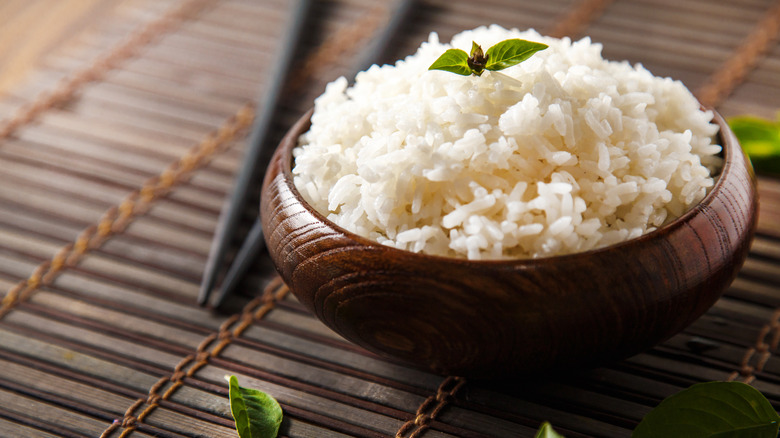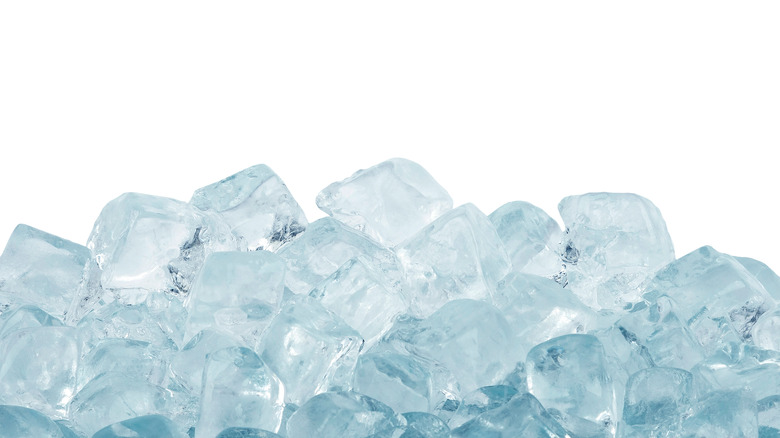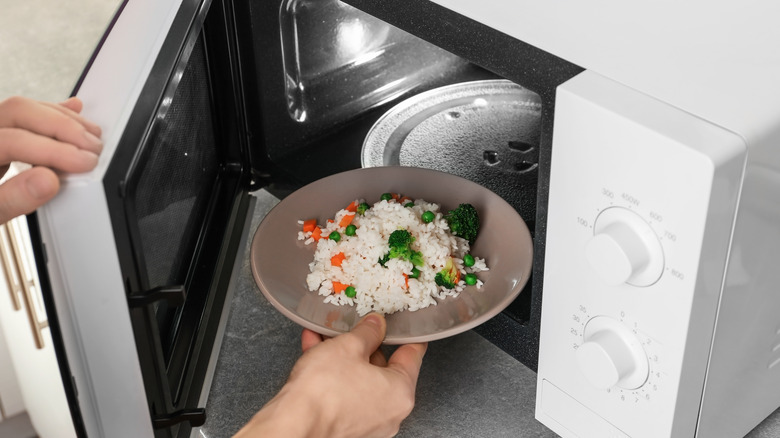Don't Reheat Rice Without Doing This Simple Trick
Making a big batch of rice at the beginning of the week is an easy way to meal prep, as this grain is the perfect base for so many delicious meals — from stir fry to curry. And, there are so many ingredients (like vegetables and a variety of spices) that you can simply add to rice for a new meal each day.
Fresh rice is soft and pillowy, especially when it's fresh out of a specialty cooker. But it can often be tricky achieving this same fluffy texture when reheating it for leftovers. When it comes to reheating foods, normally the easiest way is to pop a plate into the microwave and give the dish a quick zap. We now know the best method to reheat fried rice, but what's the preferred way to heat plain white or brown rice in the microwave to get that fluff again?
There is a trick, and it's so simple and easy. According to The Kitchn, all you need is an ice cube. They found this tip on TikTok (where we find all our kitchen hacks!). As they say, all you need to do is put an ice cube in the middle of your rice before you put it in the microwave. Wait, an ice cube in rice? Yes, doing so will create steam that makes your leftover dish feel fresh again.
Here's how this rice trick works
America's Test Kitchen caught wind of this trend and gave it a shot, noting a mysterious occurrence where the ice doesn't actually melt. The publication says the ice cube stays mostly intact because the molecules are so closely packed together that they don't vibrate when the microwave is heating things up.
For all you science obsessives out there, here's what Paul Adams — science research editor at America's Test Kitchen — had to say: "In this hack, the rice gets hot (because its grains contain water), and the heat from the rice warms up the surface of the ice cubes, so they melt a little bit. Then that liquid water released from the melting ice can be boiled by the microwave, so it turns to steam, and steams the rice."
So that's how the steaming works, but why doesn't the ice melt? Mental Floss also wrote about how this hack works, with a focus on the hydrogen bonds in the ice cube. They said, "The rigid hydrogen bonds in ice prevent the water molecules from rotating. This means the bonds don't absorb a lot of energy from the microwave, which allows the ice to retain its solid form as the surrounding food heats up."
Now that you're an expert on the science of this, you're in great shape to try out this rice reheating method and see the action happen. Ashley Abramson, the writer from The Kitchn who gave this hack a shot, used two ice cubes because she had a larger amount of ice, so you can also adjust the number of ice cubes as necessary.
How to reheat rice safely
So next time you need to reheat some rice, try out this ice cube hack, but first, it's important to make sure to check for the signs that your rice hasn't gone bad yet.
You might have heard that you can get food poisoning from rice, and while that's a possibility, you can absolutely eat leftover rice as long as you store and heat the rice safely. Keep your rice and leftovers tightly sealed. However, if the rice has been left out at room temperature for more than two hours, you should throw it away.
But how does rice cause food poisoning? When it's cooked, NHS UK explains that spores of Bacillus cereus can still survive, and bacteria will grow if you leave rice at room temperature for too long, which is why you should put away your rice quickly.
When you're reheating your rice, the temperature should be 165 degrees Fahrenheit or higher, according to Real Simple. The website suggests reheating your rice for three to four minutes, and Real Simple says you can reheat your rice by adding a couple of tablespoons of water and placing a lid on your food. If you don't have any ice cubes handy, this is another option to make your rice fluffy again.
If you have eaten rice with Bacillus cereus bacteria, NHS UK says that the symptoms last around 24 hours and describe them as "relatively mild." Still, if you think that your health and safety is at risk, contact a medical professional.


